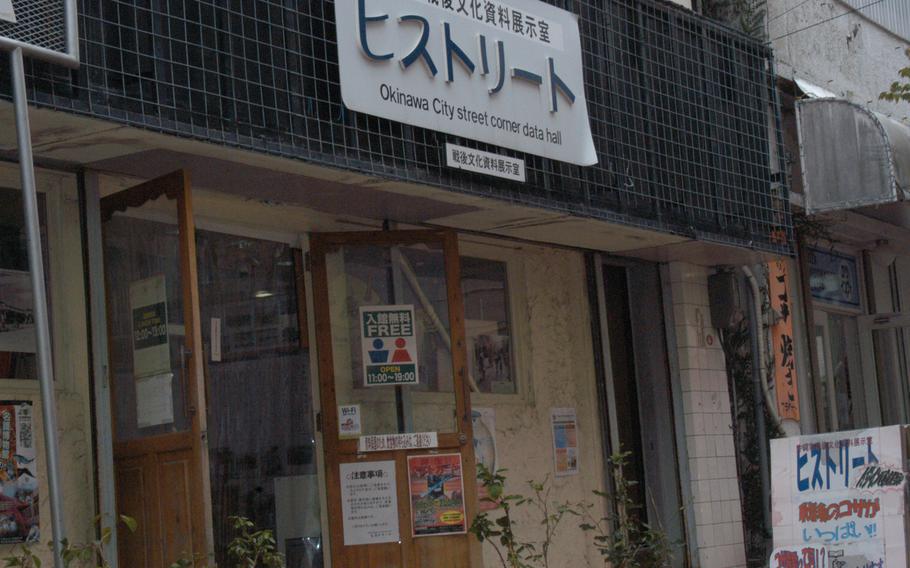
A gallery room of The Okinawa Gallery of Culture and History is conveniently located in a shopping arcade near Kadena Air Base's Gate 2. (Chiyomi Sumida/Stars and Stripes)
A history gallery in Okinawa City connects visitors with American servicemembers who once lived on the island and underwent the difficult times of post-World War II and the Vietnam War.
The Okinawa Gallery of Culture and History stands in a quiet back street of the city’s shopping alleys outside Kadena Air Base’s Gate 2. Items on display include historic documents, rare photographs, daily necessities, children’s toys and many other reminders of those eras.
Okinawa City, formerly called Koza, emerged shortly after the Battle of Okinawa ended. It rapidly grew and prospered as the neighboring air base was expanded and military operations on the island were increased as the war in Vietnam intensified. More than any other towns on the island, Koza’s history is deeply integrated with that military presence.
The exhibition rooms are in two buildings located near each other, Histreet and Histreet II.
At the original gallery, visitors are greeted by a framed document of Japan’s surrender of the Nansei islands, including Okinawa and the Amami, to the United States on Sept. 7, 1945. Panels of photographs show a signing ceremony that took place on what is now Kadena Air Base.
Behind a segment of barbed-wire fence, a common piece of scenery in the city, sits a church organ that once lifted the hearts of many children in a refugee camp on the war-torn island.
Toward the end corner of the gallery is a replica of a typical downtown bar frequented by U.S. servicemembers about half a century ago. Besides a collection of empty liquor and soft drink bottles, the bar contains one-dollar notes thumbtacked to the wall behind the counter, a popular practice at watering holes in those days. The bills bear scrawled messages and signatures of servicemembers apparently ready to be deployed to Vietnam.
A man from Sharon, Pa., wrote “Tom luvs Merissa forever.”
Above it, Lance Cpl. Gonzales demonstrated his Latino pride saying “This is for La Raza.” Others affirmed their friendship by writing their names on a greenback.
In the back of the bar is a corner that displays photographs of two major events that shook the island in the early ’70s.
The Koza riot that occurred in December 1970 was a violent protest against the military’s occupation of the island. About 5,000 residents joined in the riot, in which nearly 80 American-owned vehicles parked along a street near the air base were overturned and set afire.
Operation Red Hat was a code name for a U.S. military mission in 1971 to transfer lethal gas from Okinawa to Johnston Atoll in the Pacific, causing the evacuation of about 5,000 residents who lived near the roads where shipping trailers passed through.
Aside from the social and political upheaval, people continued to work toward a normal life, using scrap materials from military bases to create household items. A curved pot with a handle was made out of a fragment of an airplane. An empty Coke bottle was cut in half, the bottom used as a glass and the top as part of a wind chime.
At the second gallery, one of the newly added display items is military currency donated by an American who served on Okinawa in the early ’50’s, when military members had to exchange their dollars with notes issued by the military for use off base.
A visit to this little history museum is like visiting Okinawa in the ’50s through the ’70s, and a walk in footsteps left by U.S. servicemembers who came through those turbulent times.
Okinawa Gallery of Culture and History -- Histreet Directions From Kadena Air Base, take the Gate 2 Street and turn left at a covered shopping alley, two streets before reaching the Goya Intersection. Follow the alley until the roof cover ends and continue; the Okinawa Gallery of Culture and History, Histreet, is on the left side of the street.
Times Open 11 a.m. to 7 p.m. (closed noon-1 p.m.) Tuesday through Saturday. Closed Mondays, Japanese holidays and Dec. 28 through Jan. 3.
Costs Admission is free.
Food There are a number of small restaurants on the street, as well as in the adjacent Park Avenue shopping area.
Information Website (in Japanese) city.okinawa.okinawa.jp/site/view/cateview.jsp?cateid=153. Phone: 098-929-2922.
A license indicating that U.S. military personnel were allowed to frequent an Okinawan establishment was vital to local businesses.
Before being deployed to Vietnam, U.S. servicemembers wrote on dollar bills that were posted in Okinawan bars. Histreet displays many samples.
In post-World War II Okinawa, Americans had to exchange their dollars for military issued notes like these to use off base.
Items on display at the history gallery are relics from the days when both Americans and Okinawans experienced hardship.